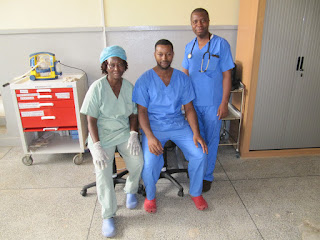The security guards had lost
control of the situation, a truck had pulled into the courtyard and a man was standing in the
back shouting at everyone and no-one in particular, his stance seemed both
threatening and desperate at the same time.
A crowd had gathered around the vehicle and the situation felt
tense. There was a cacophony of sounds
and it was impossible to establish what was happening; approaching the truck
felt like a bad idea though. I maneuvered
gently through the gathered throng and made my way into the triage room to find
a scene of devastation.
A woman lay motionless on the
stretcher in the centre of the room, two more victims sat either side; one
crying out in pain clutching his ribs and one sat quietly with a deep wound
across his forehead. There was another
patient still in the back of the truck who had apparently died on the way to
hospital. The triage nurse explained
that a lorry had collided with a mini-bus on the outskirts of town and several
people had perished at the scene. The
small, brightly coloured mini-buses or poda-podas as they are known here, are a
ubiquitous, cheap form of transport seen throughout the city and will squeeze as
many as twenty people or more onto cramped, wooden seats that would comfortably
fit half that number in what is essentially a large painted, tin can on
wheels. I shuddered at the thought of
what the accident site must have looked like.
It was rapidly evident that
nothing could be done for the lady on the stretcher and as I stood beside her,
I noticed another body curled quietly in the corner of the room; a boy in his
late teens. A pool of crimson had
congealed on the trolley next to his head, the source seemed to be his ear
indicating a significant head injury and at first glance I feared that this was
another tragedy about to be discovered.
My initial feelings of overwhelming anxiety were suppressed by my
determination to gain control over the situation and prevent further harm
whilst also attempting to preserve the dignity of those that were beyond help.
The man sitting with the wound
across his forehead was talking, lucid and had no neck pain so I was happy for
him to stay where he was for the time being.
The triage staff swiftly carried the unconscious young man into the resus
room and as they placed him on the bed, he began to vomit what looked
distressingly like fresh blood. The
medical officer was also in attendance at this point and he assessed the man
with the chest injury in the other available resus bed. His vital signs were reassuringly normal and
after analgesia, he was beginning to calm so I felt less worried; attention
focussed back on the young man that was in danger of compromising his
airway. The nurses were doing a
fantastic job supporting his neck, suctioning his stomach contents to prevent
them entering his lungs and beginning fluid resuscitation.
At one point there were six staff
around the bed, efficiently tending to him and after several attempts to get
past them to assess the patient, I gave up and stood back. The patient was now connected to the newly
installed monitors, his oxygen levels were improving and the heart rate and
blood pressure were stable so it seemed reasonable to get out of their way for
the sake of a few minutes. Fortunately,
the family had arrived by this stage and were able to afford the cost of a CT
scan and some x-rays. After a rapid
assessment which identified the head injury as the main cause for concern, we
were able to transport him to radiology.
A brief review of the scan revealed air within the skull indicating a
fracture and some swelling of the brain but to my great relief, no significant
bleeding. There is no neurosurgery
capability in the country and a sizeable bleed would almost certainly have been
fatal.
There was no point waiting for a
radiology report as this would not be available until the following day so the
patient was transferred to intensive care, by which time the oxygen and fluid
were taking effect and he was a little more responsive. I returned to A&E just an hour after I
had first arrived, the courtyard was an oasis of calm, the crowd had dispersed
and the resus was being cleaned. A
medical patient that had collapsed on his return from the bathroom in the
middle of the trauma was now safely back in bed and appeared comfortable.
The new A&E department had
only been open a week at this stage and I felt proud of the way that the team,
nurses especially, had dealt with such a major incident. The nurses staffing resus are medical nurses
and not trained in severe injury management, but they demonstrated that using
basic life-saving principles can make a real difference to patient
outcome. I added relatively little to
the proceedings and felt confident that the staff would have performed just as
well with a similar outcome had I not been present. This is the aim of what we are trying to
achieve and it has taken a lot of hard work by many people to get to this
point. It may be harder still to
maintain.
Triage Nurse Samuel

An accident waiting to happen?







